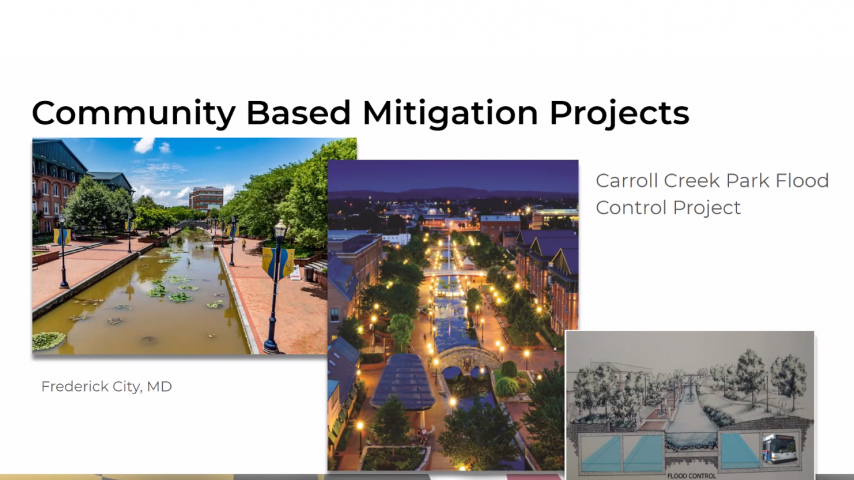
Floods are the most common and widespread of all weather-related natural disasters. According to testimony from Federal Emergency Management Agency representative Michael Grimm, flood damage cost approximately $17 billion each year between 2010 and 2018. Rising sea levels and extreme weather could cause $20 billion of flood damage to at-risk U.S. homes this year, rising to $32 billion by 2051, according to recent research by flood research non-profit First Street Foundation.
There are many causes of flooding. They include heavy rains, storm surge, quickly melting snow, and breaks in dams or levees. A flood can occur within minutes and last a long period of time. No state or territory in the U.S. is spared, and tragically, floods kill more people in the U.S. than tornadoes, hurricanes or lightning.
On May 18, 2021, the National Institute of Building Sciences hosted a panel of experts from FEMA’s Insurance and Mitigation program and the Maryland Emergency Management Agency in the webinar, Extreme Weather and Rising Sea Levels Cause More Flood Damage Every Year. What Can We Do? Subject matter experts discussed flood resilience and mitigation efforts, flood risk in the Continental U.S., and the National Flood Insurance Program. Melissa Roberts, Founder and Executive Director, American Flood Coalition, served as moderator.
WE CAN EXPECT MORE FREQUENT AND INTENSE DISASTERS
David I. Maurstad, FEMA Deputy Assoc. Administrator for Insurance & Mitigation and Senior Executive of the National Flood Insurance Program, said there were 47 major disaster declarations in 2020. These disasters cost $95 billion in damage.
“We can expect more frequent and intense disasters,” Maurstad said.
The mission of the Building Resilient Infrastructure and Communities (BRIC) program is to reduce recovery costs and human life, support states and communities as they undertake new infrastructure projects, and shift the federal focus toward proactive investments in community resilience.
For the inaugural application period, Maurstad said there is $500 million available. So far, officials have received 980 supplications – nearly 90 of which came from impoverished and vulnerable communities. These supplications add up to a total project cost of $5.49 billion. Project selections will be announced this summer.
BUILDING CODES ENHANCE PUBLIC SAFETY
It’s important to build hazard mitigation practices into other local planning efforts and budgets. One way to make this happen is for communities to adopt hazard resistant building codes.
Building codes enhance public safety and property protection. But only 37 percent of communities have adopted hazard resistant codes.
“We need to expand the adoption of building codes and make it standard practice,” Maurstad said.
For every $1 invested to enhance public safety and property protection, it could translate into $4 of post-disaster savings.
Ninety-nine percent of U.S. counties have experienced a flood event, he said. This is why Equity in Action truly is a transformational leap forward.
Equity in Action premiums will more accurately reflect a property’s unique flood risk by considering a broad range of variables, including a property’s cost to rebuild. This alone is a significant improvement.
“Equity in Action is not a check-the-box program, and we move on,” Maurstad said. “We must plan for the future. Successful preparedness … will make us all safer.”
MITIGATION IS THE CENTER OF THE UNIVERSE
While addressing climate change, the state of Maryland is placing mitigation at the forefront its work, said Jaleesa Tate, State Hazard Mitigation Officer and Branch Manager with the Maryland Emergency Management Agency (MEMA).
Maryland is reducing its risk with a multi-pronged approach: Implementing hazard mitigation projects and performing hazard mitigation planning/risk assessments, looking closely at legislation and policy, building partnerships, doing more education/outreach to ensure people are aware of their flood risk, and disaster risk reduction by looking at multiple sectors.
“Emergency management may not be the best approach to everything,” Tate said, mentioning that Maryland is experiencing more intense and frequent flooding, which overwhelms aging infrastructure.
MEMA currently is shifting the idea of emergency management in the state, looking specifically at mission areas of emergency management and where there may be opportunities to mitigate risks.
“It’s like we’re always waiting for the disaster to happen,” Tate said. “We cannot respond our way out of vulnerability.”
One success story that has been 30 to 40 years in the making, Tate said, is a project in Frederick City, Maryland, that addresses flooding, economic development, and historic preservation. Frederick mitigates flooding to its core with the help of two large underground culverts that quickly dissipate floodwaters.
THE NEXT RESILIENCE 2021 WEBINAR: HURRICANES
The next Resilience 2021 webinar – The 2020 Hurricane Season Saw a Record Number of Storm Formations—What’s in Store for 2021? – takes place June 23.
Our panel will cover hurricane risks and mitigation, factors for storm strength, and the future of the Atlantic Hurricane Season.
To register, visit: Resilience 2021: The 2020 Hurricane Season Saw a Record Number of Storm Formations—What’s in Store for 2021? | National Institute of Building Sciences (nibs.org)




